The NVIDIA GeForce GTX 780 Ti Review
by Ryan Smith on November 7, 2013 9:01 AM ESTPower, Temperature, & Noise
As always, last but not least is our look at power, temperature, and noise. Next to price and performance of course, these are some of the most important aspects of a GPU, due in large part to the impact of noise. All things considered, a loud card is undesirable unless there’s a sufficiently good reason – or sufficiently good performance – to ignore the noise.
| GeForce GTX 780 Series Voltages | ||||
| GTX 780 Ti Boost Voltage | GTX 780 Boost Voltage | GTX 780 Ti Base Voltage | ||
| 1.187v | 1.1625v | 1.012v | ||
Taking a quick look at voltages, we find that our GTX 780 Ti operates at a slightly higher voltage at its maximum boost bin than the original GTX 780 did. The difference is minor, but the additional voltage may be necessary to hit the slightly higher clockspeeds GTX 780 Ti operates at relative to GTX Titan and GTX 780.
| GeForce GTX 780 Ti Average Clockspeeds | |||
| Max Boost Clock | 1020MHz | ||
| Metro: LL |
1000MHz
|
||
| CoH2 |
997MHz
|
||
| Bioshock |
954MHz
|
||
| Battlefield 3 |
980MHz
|
||
| Crysis 3 |
980MHz
|
||
| Crysis: Warhead |
1000MHz
|
||
| TW: Rome 2 |
950MHz
|
||
| Hitman |
993MHz
|
||
| GRID 2 |
967MHz
|
||
| Furmark |
823MHz
|
||
Moving on to clockspeeds, we find that the GTX 780 Ti does very well when it comes to boosting. With a maximum boost clock of 1020MHz, we have 2 benchmarks averaging 1000MHz, and another 4 averaging 980MHz or better.
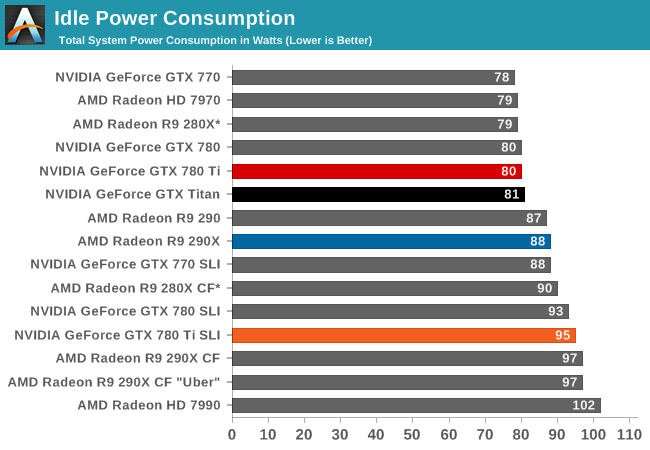
With all of our GK110 cards sharing a common design, at idle there’s very little to differentiate them. Other than GTX Titan’s extra 3GB of VRAM, we’re essentially looking at identical cards when idling.
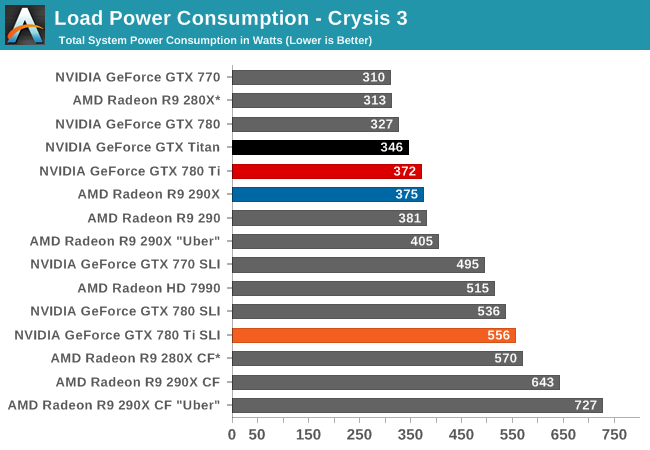
Moving on to load power, we can see the power/heat ramifications of the slight clockspeed increase coupled with the activation of the 15th SMX. Even with the further optimizations NVIDIA has put into the new revision of GK110, power consumption has gone up in accordance with the higher performance of the card, just as we’d expect. Since NVIDIA doesn’t notably alter their power efficiency here, that increased performance has to come at the cost of increased power consumption. Though in this benchmark it’s worth pointing out that we’re measuring from the wall and that GTX 780 Ti outperforms GTX Titan by 8%, so some of that 29W power difference will come from the higher CPU load caused by the increased framerates.
As for the GTX 780 Ti SLI, here we see power level off at 556W, 20W more than the GTX 780 SLI. Some (if not most) of that is going to be explained by the increased CPU power consumption from the GTX 780 Ti SLI’s higher framerates. Coupled with that is the fact that in SLI setups these cards get hotter, and hence have to downclock a bit more to maintain equilibrium, which helps to offset the increased power requirements of GTX 780 Ti and keep the SLI results so close to the GTX 780 SLI results.
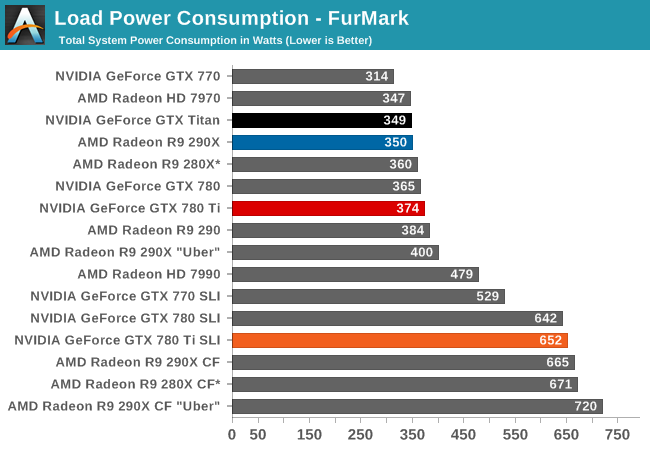
Switching over to FurMark, we find that power consumption is also up, but only slightly. With GPU Boost 2.0 clamping down on power consumption all of our GK110 cards should be clamped at 250W here, and with a difference between GTX 780 and GTX 780 Ti of under 10W, that’s exactly what appears to be happening here.
On a side note, it’s interesting to note here that under FurMark we’re seeing the GTX 780 Ti draw more power than the Radeon R9 290X. Despite the fact that the 290X has a higher rated TDP, in the card’s default quiet mode the card can’t actually dissipate as much heat (and thereby consume as much power) as the GTX 780 Ti can.
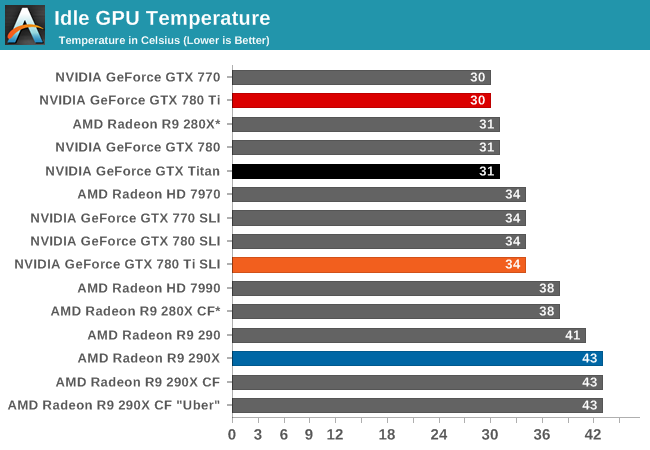
For idle temperatures we’re once again looking at cards that are for all intents and purposes identical. At 30C the GTX 780 Ti easily stays nice and cool.
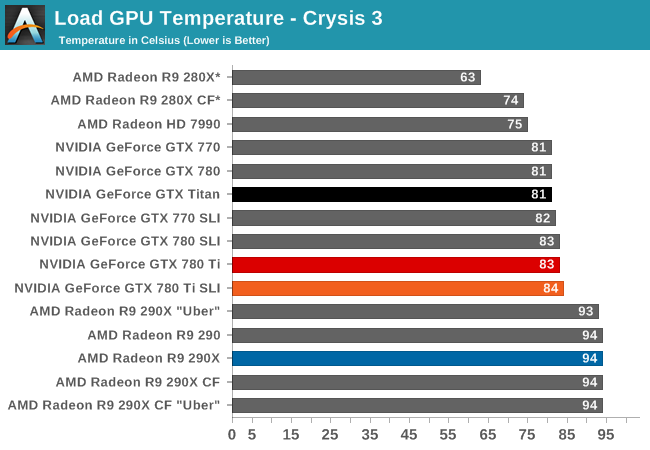
As we mentioned in our look at the GTX 780 Ti hardware, NVIDIA has increased their default temperature throttle point from 80C on the GTX Titan/780 to 83C on the GTX 780 Ti. The end result is that in all of our temperature limited tests the GTX 780 Ti will peak at 83C-84C, whereas the older GK110 cards will peak at 80C-81C.

FurMark reiterates what we saw with Crysis 3. The temps are up a bit across the board, while the GK110 cards are holding near their throttle points. The SLI setups meanwhile approach the upper-80s at 88C, reflecting the fact that even with blowers, there’s some impact on neighboring cards in high load situations.
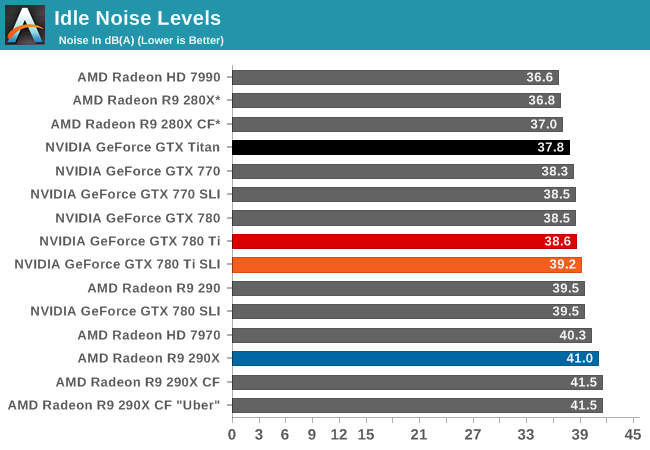
Our last idle scenario, we once again see all of our GK110 cards performing similarly, with idle noise levels in the 38dB-39dB range.
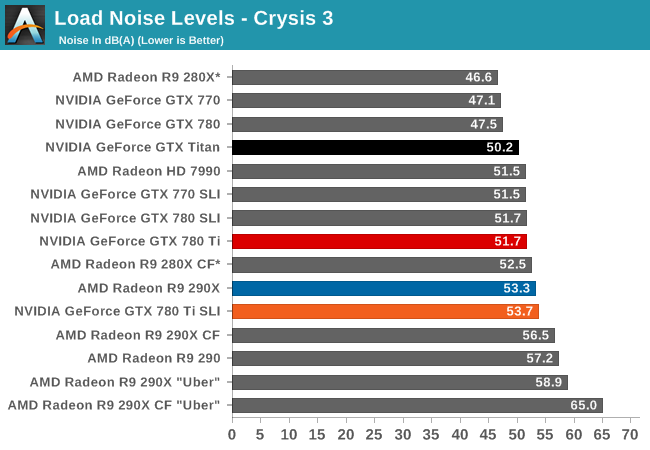
Moving on to our gaming load noise results, we can see the full repercussions of the GTX 780 Ti’s higher average power consumption coupled with the card’s higher temperature throttle point. Moving the throttle point along the same curve has the end result of moving higher the equilibrium point and thereby the card’s operating noise levels. As the fastest single-GPU card on this card, the GTX 780 Ti is still doing very well for itself and for a blower based design at 51.7dB, though at 1.5dB louder than GTX Titan and 4.2dB louder than GTX 780 the noise tradeoff for the card’s higher performance is very clear. Meanwhile the fact that it’s tied with the GTX 780 SLI comes with its own bit of irony.
Speaking of the GTX 780 SLI, we can see the noise impact of SLI configurations too. The GTX 780 Ti SLI levels out at 53.7dB, 2dB louder than our single-card configuration and 2dB louder than the GTX 780 SLI. At this point it’s just a bit louder than the 290X and quieter than a number of other 290 series setups.
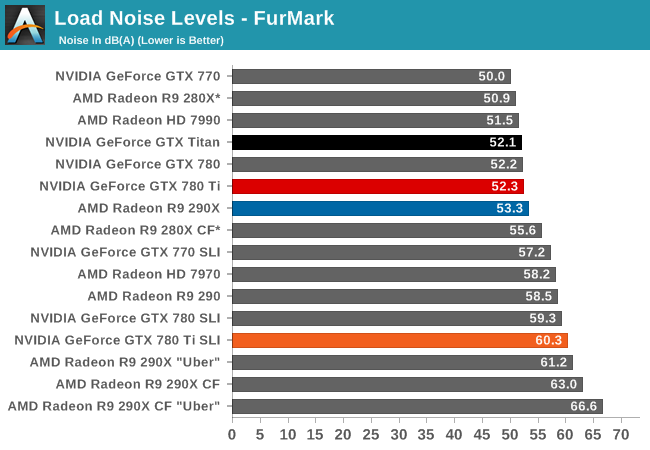
Finally with load noise levels under FurMark we can see where our various cards will peak at for noise levels. The GTX 780 Ti creeps up to 52.3dB, essentially tying with the GTX 780 and GTX Titan. Otherwise it comes in just behind the 290X, and the start of the pack for our multi-GPU setups.
As for the GTX 780 Ti SLI, like our single-card comparison points its up slightly as compared to the GTX 780 SLI.
Overall, our look at power, temperatures, and noise has been a rather straightforward validation of our earlier suspicions. GTX 780 Ti’s higher performance leads to higher power consumption, and will all other factors being held equal – including the cooler – power, temps, and noise levels all rise a bit as compared to GTX Titan and GTX 780. There’s no such thing as a free lunch here, and while GPU Boost 2.0 will keep the maximum levels suitably in check, on average GTX 780 Ti is going to be a bit worse than the other GK110 cards due to those factors. Though even with the increased noise levels in particular, GTX 780 Ti is still able to outperform 290X on noise while also delivering better gaming performance, which makes this another tidy victory for NVIDIA.










302 Comments
View All Comments
dwade123 - Friday, November 8, 2013 - link
Only morons will buy current gen cards on steroids.MLSCrow - Friday, November 8, 2013 - link
Never in all my life of being a supporter of Anandtech have I been so disgusted by the overly obvious bias toward NVidia. The GTX780Ti is a JOKE at $700.just4U - Friday, November 8, 2013 - link
As much as I hate to admit this.. I "DO" like to see AMD succeed.. that being said I don't favor them over NVidia.. and Anandtech's reviews are fair/balanced. I think all reviewers have a preference.. and sometimes that shows in their reviews.. but it's really hard to pinpoint what Ryan's are. The guy can't win with NVidia or AMD die-hard fans. He gets criticized for being a fanboy of both.Ranger101 - Friday, November 8, 2013 - link
I hear you, I have followed Anandtech for decades but this kind of rubbish is definitely making me think about looking at other tech sites for a balanced perspective...shame on you Anandtech.Ranger101 - Friday, November 8, 2013 - link
At 4K resolutions the R290X beats 780Ti every time. How is it possible to conclude that 780Ti is 11% faster than R290X when the former card is consistently beaten at 4K resolutions which is the ultimate test of a cards speed? How much is Nvidia paying you to write this junk?polaco - Friday, November 8, 2013 - link
Indeed that performance difference is very tricky. In most cases they are head to head. And for 150 bucks less it's a no brainer 290X is the winner. However 290 seems so sweet at that price that puts me into real doubt if 290X is worthy. Radeon 290 looks lovely.Yojimbo - Friday, November 8, 2013 - link
He explains his reasoning quite clearly, and I think the reasoning is sound. 4K resolution is still out of the reach of a single-GPU card, because in order to achieve it, one must either accept painfully low frame rates, or run on extremely low quality settings, no matter what single-GPU card is chosen. Neither of these options makes much sense, but if you wish to take advantage of them, the data is there and you are free to ignore his analysis and pursue your own; Buy a 290X and a 4K monitor. But in terms of "victory" for AMD, it seems to me that running 4K somewhat faster, but still not fast enough to be usable, is meaningless.Jaboobins - Friday, November 8, 2013 - link
The memory frequency for the GTX 770 is wrong. It needs to be 7Ghz not 6Ghz.But damn is that 780 GTX ti is fast!
wwwcd - Friday, November 8, 2013 - link
I got a rumour for r9 290x with 8GB 7+ GHz GDDR5 VRAM. WoW!, if that will be made real the card be have twice speed bandwidth than normal refferent r9 290x. GTX 780 will be downed to ground. Hardly ;)slickr - Friday, November 8, 2013 - link
At $700 its a bit too expensive, especially when you consider it averages only about 5% increase in performance over the Titan and about 9% increase in performance over the 780, which when translated to raw numbers, its only 3-4 frames.I mean whether a game runs at 50 or 54 frames is of no significance, especially if you have to pay $200 more for it.
I think the 780 Ti is good in its own right, but its just not good enough when compared to the competition and when you consider the price.
The 290x is $550 and in some cases is still faster than the 780 Ti, all this with a terribly designed cooler, which will be replaced by custom coolers by 3rd party in the next week or two.
So at this point we are looking at a $550 290x with a custom cooler that will be able to run even faster with a better cooler, which means beating the new 780 Ti in many benchmarks and drawing in others all at $150 less.
So yeah, Nvidia may have released a slightly faster card than the 780 and Titan, but considering the price and what the competition is offering, it isn't very appealing.
If it launched at $600 it may have been reasonable and you have a 10% slower 780 at $500 and in between the 290x at $550 and it could make sense to go for the 780Ti, but right now I don't really see the appeal.